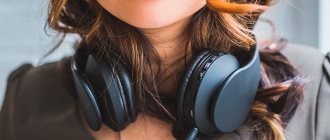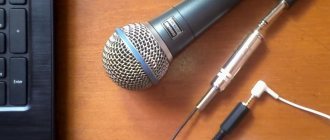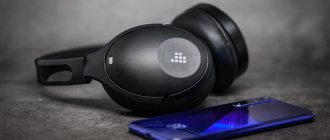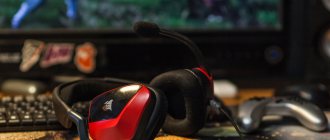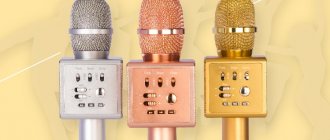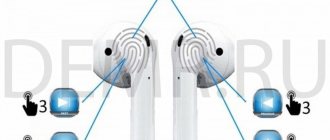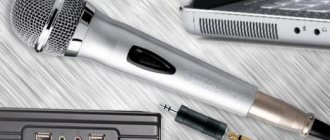How to connect an external microphone to a smartphone
Connecting a microphone to your phone is done in the following ways:
- Via a cable with a mini-jack connector
- Via USB cable
- Via Bluetooth radio
It doesn’t matter at all whether it is micro electrodynamic or electret. This applies to devices where the power source (battery) is installed in the housing. Studio-type voice instruments that require external 48 V power are used with special adapters. It's easy to connect a wired microphone to a phone or smartphone, but you can't do it directly. The fact is that mobile communication gadgets are equipped with four-pole connectors, the pinout of which does not coincide with the mini-jack of the external voice device. Therefore, to connect a wired microphone to your phone, you will need an adapter.
Usually this is a small piece of cable at one end of which there is a connector that is inserted into a mobile device. The socket on the other side is for connecting a micro. In addition to a simple adapter, you can connect a splitter to your smartphone, which allows you to use micro and headphones. There are adapters without cable. This is a plastic block that is inserted into the socket of a mobile phone. After connecting external devices, the corresponding icon should appear on the screen. It signals that the device has been identified and the system sees it. When connecting a microphone to your phone, there is no need to install drivers or other software. If the icon does not appear and the device does not work, you need to check the voice device and the adapter cable separately. To connect a lavalier microphone to your phone, you do not need any special equipment. They are connected through special adapters, like other types of devices.
Connecting microphones
The choice of equipment always determines the purpose of its use. People of different professions have their own requirements for a sound recording device. The equipment is divided into wired and wireless.
Wired devices
The following types of headsets are distinguished:
- “Pelichka.” A wire 1.5 m long is enough. If it is more than 7 m, you need a cylinder on which the cable is wound to make work comfortable. To record audio material from a lavalier microphone to a smartphone running Android OS, a splitter is used as an adapter. Without it, smartphones can only detect condenser loops.
- Rode SmartLav+. Professional model. Directional type: circular. Made in a metal case with a wire in strong insulation. Fits into a 3.5mm jack and is compatible with Android. Wind protection and a crocodile clip are provided.
- The microphone is a “gun”. Does not have the disadvantages of lavalier audio devices. He writes the sound in front of him, sanding to the sides, and the result is a clean sound.
- Saramonic SmartMixer. This is a system with which you can make stereo recordings. Includes mixer, grip and 2 directional microphones. If necessary, they can be replaced with others - 3.5 mm jacks are used for connection. An additional mini-XLR connector can be used to connect a vocal microphone.
The mixer in Saramonic SmartMixer is connected to a smartphone via a 3.5 mm output - the kit contains the necessary cable. The screen displays the sound level for each track. The volume parameter is adjusted using a toggle switch. The system powers remote microphones and maintains a charge from a 9V battery. The operating time of the equipment is up to 2.5 hours.
Wireless devices
Connected via Bluetooth connection. To switch devices, you need to pair them. Setting up Bluetooth on each gadget is different - you need to read the instructions that are in the box with the equipment.
The Sennheiser Memory Mic (“lovaliere”) model is popular. Its type is condenser, its direction is circular. Sennheiser Memory Mic interacts with the Android system via bluetooth 4.1 protocol and operates remotely. For full-fledged work there is a native program. The battery holds a charge for 3-3.5 hours. The USB Type-C port is used to charge the device. Thanks to these parameters, the microphone becomes a means for recording high-quality video and creating a small recording studio on the phone platform.
How to connect a microphone to an Android phone
Connecting a microphone to Android or other operating systems installed on mobile phones is no different. The main thing is to choose the right adapter. Most often, the following designs are used to connect the micro to phones or smartphones:
- Boya BY - CIP2
- Saramonic SmartRig II
- Rode SC6
BoyaBY-CIP2 is a low-cost transition device. It consists of a piece of cable 10 cm long and two connectors. The TRS plug is inserted into the corresponding socket on your phone, smartphone, iPhone, iPad or iPad Touch. A voice device with a TRS connector is plugged into the socket at the other end of the cable.
Saramonic Smart RigII is used to connect an external professional-level microphone with an XLR connector to Android. The device has a pre-regulated amplifier, which is important when working with voice devices with a weak signal level. A Krona type battery is installed in the adapter's battery compartment. The adapter unit has a voltage converter that provides phantom power to an external voice device.
The Rode SC6 adapter module allows you to connect two microphones and headphones to Android. The device is suitable for all types of smartphones and tablet computers.
This model has the Rode SC6-L variety, which connects via the USB connector provided on some smartphones. An audio interface with two voice inputs is suitable for podcasting or recording interviews on a mobile device. The ADC operates with sampling rates of 44.1 and 48 kHz at 24 bits.
Solving possible problems
Unfortunately, sometimes when connecting and using an external audio device on Android you may encounter certain problems. Let's look at the most common ones and suggest methods for solving them.
The connected microphone is not recognized
As practice shows, this is the most common possible failure and occurs due to incorrect connection or hardware faults. You can check this as follows:
- Make sure your microphone is working by connecting it to a compatible device (such as a computer) and checking that the audio input is working.
Read more: Checking the microphone in Windows OS - If the gadget is working properly, the problem may be caused by adapters, especially if a USB connection is used - often defective ones are found among cheap copies.
- At the same time, examine the sockets on the target device - very often dust or dirt can accumulate in the connectors, which prevents the adapter from being inserted all the way, which is why the smartphone/tablet cannot recognize the microphone. It is also a good idea to clean the ports with a cotton swab and alcohol.
There is usually no point in repairing faulty microphones and adapters; it will be easier to replace them, while failures in an Android device can be repaired at a service center.
The microphone is connected, but does not work or does not work correctly
This problem can occur due to both hardware and software reasons.
- The first is similar to the previous one discussed and almost always means a hardware malfunction of either the microphone itself or the adapter used. Try replacing the devices with ones that are known to work and check their behavior.
- Sometimes the source of the failure can be a smartphone or tablet - for some reason the system does not disable the built-in solution, which is why the external one cannot be used. As a rule, in such cases, a reboot helps, but if it does not bring any effect, the problem is some specific firmware parameters, which, alas, cannot be changed by the user.
- Also, not every Android program for recording sound or video can work with external microphones. Typically, support for such devices must be declared by the developer, so if in doubt, contact him or otherwise clarify this information. If it turns out that the software does not work with the connected audio output devices, simply select an analogue one.
We are glad that we were able to help you solve the problem. In addition to this article, there are 12,721 more instructions on the site. Add the Lumpics.ru website to your bookmarks (CTRL+D) and we will definitely be useful to you. Thank the author and share the article on social networks.
Describe what didn't work for you. Our specialists will try to answer as quickly as possible.
How to connect a microphone to a phone without an adapter
To connect a microphone to Android without using adapters, you need to use voice devices specially adapted for such purposes. For the convenience of users, the micro-looplet is attached to clothing and connected to a mobile device via a cable. Other models are called “gun”. They do not have a cable and are installed on the smartphone body.
- Rode Smart Lav+
- Shure motiv MUL
- Comica CVM-VS08
- Rode Video MicMe
The first two models are lavalier devices compatible with any Android and iOS devices. Supplied with a windproof cap and a spring clamp. Provide voice signal broadcast in the range of 45 Hz-20 kHz.
Micro guns have a cardioid polar pattern, which eliminates extraneous noise in the voice signal. Some types of voice-activated devices only work with Apple products. This must be taken into account when choosing a voice device. When connecting a USB microphone to your phone, you may need to install a utility to configure the voice channel. The easiest way is to use the Microphone 1.6 application. It is downloaded from GooglePlay.
Microphone setup and testing
After connecting the device, it is recommended to verify its functionality and, if desired, configure it. Both procedures are performed through software that can work with external microphones, such as Open Camera, which is popular among many mobile photography enthusiasts.
- After downloading and installing, open the application, then in its main window, tap on the gear icon.
- In the list of parameters, select “Video Settings”.
- Use the “Sound Source” setting.
Next, click on the “External microphone...” position.
Close the application settings and shoot a test video to check the changes made - if the result is unsatisfactory, try reconnecting the device or use other software.
How to connect a wireless microphone to your phone
You can connect any voice device equipped with a Bluetooth module to your mobile phone and smartphone. In order for a communication channel to be formed between gadgets, you need to activate the Bluetooth function on both devices. There is a special button on the body of the voice device that turns on this mode. Settings may differ for different devices, so you must refer to the operating instructions to create a connection. On a smartphone, the Bluetooth function is selected in the menu. When the micro is turned on and configured, the mobile phone finds and identifies it. Some smartphone models do not enable sharing mode until the PIN code is entered. Most often this is 0000, but there may be other numbers. The speaker and microphone are connected to the phone in the same way.
Connecting a wired microphone via a special connector
How to connect a microphone to a phone if it is cable:
- Via a standard 3.5 mm audio connector (may also be called 3.5mm female TRRS, Jack 3.5 in instructions).
- Via USB connector. On most phones, this is the device's charging port.
Be careful : when choosing any of these methods, you will need to purchase a special adapter.
If you choose a 3.5 mm jack, the difficulty is that the smartphone plug has 4 contacts (TRRS), and the microphone plug has 3. Hence the conclusion: if you just connect the cable to the phone, the device will not record sound. With the exception of special microphones designed to function in conjunction with a smartphone. Specific models include GORA Lavalier or Rhode Smartlav +.
Purchase a TRS/TRRS adapter from an electronics store. Please note the year your phone was manufactured:
- Until 2011 - OMTR standard plug.
- After 2012 - CTIA standard plug.
conclusions
Android phones do not have a line input; sound recording is only possible through the line input of an external USB sound card.
A simple user needs headphones and a microphone, a headset, this is what the consumer segment is designed for.
A line input is only for musicians: this is probably what manufacturers think :) Musicians need high-quality sound. And for a “warm tube” you can charge a lot of money, so the linear input is increasingly being used in specialized devices. The trend is so-so. If you know about a cheap “whistle” sound card that is inserted into a USB connector and has a line input, please write. I didn't find one.
And one more thing: I became interested in this issue - and I found a definite solution. Write to me on the topic “Why do I have a problem with such and such a phone model and such and such an external card?” - useless: I don’t have that phone model or that sound card. Try different phone models - borrow from friends and acquaintances. Also, I don’t know why you are experiencing any glitches - my system worked, and it was enough for me to get an answer to the question stated in the title. And this solution has not become the main one - if I need a line input, then I use a separate Zoom H1n recorder.
Wide range of settings: Blue Microphones Mikey
Blue Microphones Mikey
This rugged beauty is built to handle loud sounds - according to the specification, it can handle up to 130dB of volume.
To understand what this parameter is, it must be said that the volume at a rock concert fluctuates around 120 dB, so you should feel quite comfortable.
There are three gain modes - quiet, auto, and loud.
The gadget adapts depending on the situation, and its protection is able to reflect unwanted noise.
The device also has a micro-USB port that allows you to charge your iPhone/iPod/iPad using the microphone. This option is implemented just in case there is a long recording ahead.
Unfortunately, the device blocks the headphone port on the iPhone 6 and iPhone 6S.
You will not be able to use headphones for monitoring.
Therefore, in places where constant tracking and monitoring is required, it is worth using a different device.
iPhone 6/6S users - you can still use it for demo recordings, or capturing a video of your favorite band, but when using it for studio work, be prepared for the inevitable disappointments.
Positive:
- Stereo capture
- Rugged housing
- 230 degree rotation
- Micro USB port for charging your phone while recording
- Built specifically to handle loud environments (130dB), and can cancel out unwanted noise
Negative:
- Blocks the headphone jack on the iPhone 6/6c model
- Cannot be used with smartphones with cases
Recommendations
If we talk about recommendations for connecting a microphone to a phone, there are several worth noting.
- You should select the microphone to suit your needs as much as possible . If it is used for interviews, then certain requirements will be placed on it, and if it is used for sound recording, then completely different ones. And the more clearly you understand why you need a microphone, the better option you can choose.
- Another recommendation concerns the selection of the correct microphone adapter. And you definitely need to check its performance when purchasing, so as not to buy a low-quality item and discover it at the most inopportune moment.
- You should use special software for the highest quality microphone control . Its use will make it possible to significantly simplify its use and save a lot of time. In addition, this software often makes it possible to configure the microphone in accordance with certain user wishes. Here it should be added that it very rarely happens that the phone automatically adjusts the microphone so that its operation suits the user.
- It is better to give preference to products from trusted brands. Their devices are made of high-quality materials, thanks to which they operate smoothly and make it possible at the hardware level to provide good and clear sound recording in almost any conditions.
For more information on how to connect a microphone to your phone, see the following video.
